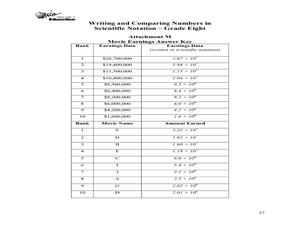Ohio Department of Education
Writing and Comparing Numbers in Scientific Notation-Grade Eight
Explore scientific notation in this mathematics lesson. Young mathematicians explore multiple representations of large number in scientific notation through the use of models, visual representation and expanded form. The lesson provided...
Curated OER
Cuentitos para ni
Vamos a escribir! Your older learners will love writing a children's book for learners at the elementary level. The resource suggests having small groups write their stories and create PowerPoint slides with illustrations, but this can...
Curated OER
From Graphic Organizer to Composition - Grade Six
How does one use a graphic organizer to plan writing? Introduce your writers to different types of graphic organizers by dividing the class into groups and assigning each group a particular organizer. Then, as they research chocolate...
Curated OER
Multiplication Worksheets
This is a simple fourteen problem practice instructional activity for multiplying three-digit whole numbers. Additionally, there is a space provided to record students' scores and the teacher's comments. This instructional activity does...
TryEngineering
Nano Waterproofing
Does your shirt hate water? In the activity, future engineers observe the hydrophobic effect in fabrics. They brainstorm and test some ideas for waterproofing fabrics.
Curated OER
Cell Structure and Function
Does your biology class know how the parts of a cell—or how they connect to each other? A word bank provides vocabulary terms for learners to complete a concept map regarding general cell structure and function.
Curated OER
Graphing Lines That Don't "Fit"
How can you graph lines that don't seem to fit on the given graph? What makes a line straight? What does the rate of change mean when graphing a line? How do you know if a slope is positive or negative? How do you know if the graph of a...
Curated OER
Analyzing Two or More Nonfiction Texts
How does recognizing the author's purpose help you draw conclusions about a topic? Using two articles (both are attached), learners brainstorm why each author wrote each article. Are their purposes similar or different? Learners use a...
Curated OER
Purposes of Reading Fiction and Nonfiction
How does the purpose of a fiction book differ from the purpose on a non-fiction text? Model for your young readers a scenario in which each kind of book might be useful or fun to read and show examples of each genre. A list of suggested...
Curated OER
What is a Philanthropist?
What does a philanthropist do? Help your class explore philanthropy using character development and literacy ideas. Learners will define and give examples of philanthropy, listen to The Lion and the Mouse, discuss how the characters help...
Curated OER
A Year in Review: The Memoir
If you are planning a unit on memoir and autobiographical narrative, you should consider this resource. Using Internet research skills, pupils review works by James Frey and Henry David Thoreau. In response to these works, learners...
Curated OER
Farming: It's a Fact
What does it take to work in agribusiness? Conduct and explorative investigation which describes where our food dollars go, who makes money on what we buy, and jobs related to agriculture. The class plays an interactive game, analyzes a...
Curated OER
Macromolecules
Titled "Macromolecules," this worksheet does not cover carbohydrates. However, it is a worthy quest to uncover the properties of lipids and proteins. Biology pupils write short answers to detailed questions about the structure and...
Curated OER
Classification/Taxonomy/Statistics Review
"Does King Phillip Cry Over Flimsy Grass Stems?" You might not answer that question with this exhaustive worksheet, but your biology class will get the full scoop on the hierarchy of biological classification with this resource. It...
Curated OER
Raven Chapter 14 Guided Notes: DNA, the Genetic Material
Because it is heavily focused on the contributors to DNA theory, this instructional activity may be more of an enrichment than a fundamental support to your genetics curriculum. Though it does query learners about DNA structure,...
Curated OER
Telling Time to the Hour
An engaging presentation on telling time, and figuring out elapsed time, awaits your young learners. Understanding analog clocks an elapsed time are crucial skills for all students to master. This presentation does an excellent job of...
Curated OER
Carbon Dioxide - Sources and Sinks
Where does all of the carbon dioxide come from that is supposedly leading to climate change? Earth science pupils test animal, plant, and fossil fuels as sources in this investigation. Using an indicator, BTB, they are able to detect the...
Curated OER
Geography of Australia: The Shaping of a Continent
Whether you are embarking on a unit on ecosystems, or on the characteristics of the Australian terrain, this picture-packed presentation would be a great one to use. Not only does the presentation contain useful information, it also has...
Curated OER
Fire Safety
After studying the Great Chicago Fire of 1871, teach your students some fire safety tips and techniques with this important PowerPoint. Not only does this presentation include tips, but it has facts about fire that are important to know...
Curated OER
Chapter 13: Money and Banking
Where does money come from? If your class can't answer this question (beyond "my parents"), this presentation will be a timely and appropriate way to teach them. Details about currency, money supply, and the banking system, help explain...
Curated OER
Imperialism: J.A. Hobson (1902)
J.A. Hobson was a popular writer, economist, and critic of Imperialism. Learners will read a short excerpt from one of his publications and answer two, two-part questions regarding his views on Western imperialism in Asia. Tip: Ask your...
Curated OER
Writing Exercises: World War I, #3
What does your class know about WWI? They can share their knowledge by responding to three short-answer questions. They'll discuss human rights issues during WWI, the role of imperialism, and causes of the war from the perspective of the...
Curated OER
Types of Jobs: Beginning ESL PowerPoint
Using picture prompts and a few easy-to-understand details, ESL students reinforce their knowledge of common occupations in this presentation. Jobs such as mailman, nurse, and cashier are featured with fun illustrations. For an increased...
Curated OER
Ambiguity and Puns
Get a giggle from this presentation about puns and ambiguity. From ad campaigns to old jokes to pictures of animals made out of vegetables, the slides are amusing, informative, and bizarre. The presentation spends more time providing...
Other popular searches
- Picture Does Not Belong
- Life Doesn't Frighten Me
- Al Capone Does My Shirts
- Do and Does
- Sentence Doesn't Belong
- Which Word Does Not Belong
- Beatrice Doesn't Want To
- Does Not Belong
- How Does Light Travel
- Sentence Does Not Belong
- Which Does Not Belong
- Anansi Does the Impossible























